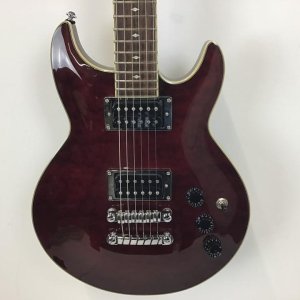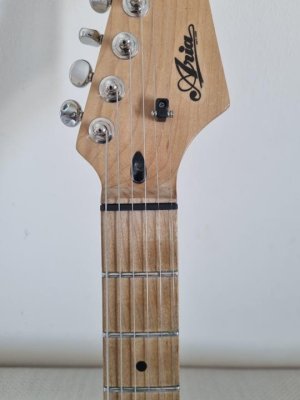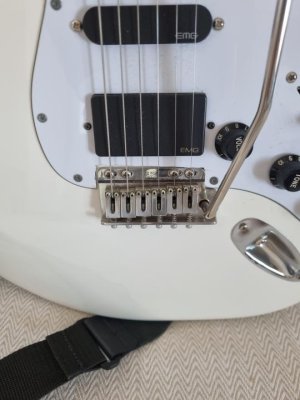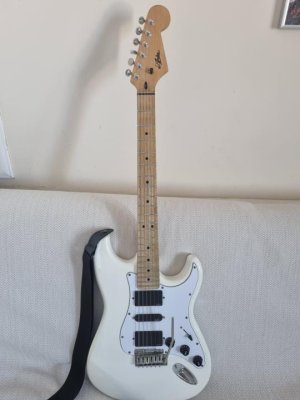Hello dear friends!
I have this thought that has been around in my mind for a while, I have the following gear :
- Aria Strat, from 1983, (I got it when I was 14 yrs old), 21 frets, vintage-y, 3 SC, my son has it with him in the city where he studies but never plays it, so I am think of getting this back and do some restoration , great guitar
- Kramer 210, super strat, 22 frets, Floyd Rose-II, HH , Seymour Duncan livewires, nice guitar but with unpleasant/uncomfortable heel access and too heavy, I think more than 4.2KG or so
- Carvin DC135, 1988, 24" scale, second++ hand, Floyd Rose, HSS, I bought it in a terrible condition sometime in 1997, then restored it heavily, converted to right hand, absolutely nice guitar , but is also heavy 4.2KG same weight like the kramer
- Ibanez ARZ800, single cut, to cover the Les Paul tones
- Ibanez UV70p for the 7-string, low tuning, etc stuff
- A strat I made 3 years ago, white body, maple fretboard (the only maple fretboard I have), 22 frets, EMG 85 (bridge), S, 81 (neck) , I put it together from various parts, I made easy heel access, super light, so nice to play, great sound, sustain (I was lucky with this guitar), this is my main guitar.
- An acoustic Yamaha which I gave to my son, permanently
Also I play in a band : https://www.youtube.com/@theband6695 and standing for 2-3 hrs during shows kind feels better with a lighter guitar.
I would need the same as the last white maple fretboard no-name strat but with floyd, I could use the 7-string Ibanez as this is comfy, and nice to play, but still I make mistakes with the 7-string for the ordinary traditional 6-string songs.
So the dilemma, with so many guitars (of which some go unused) is it wise to assemble / make a new a new guitar? Or risk and floyd-rose the no-name , accepting I could ruin such a great guitar ?
Or try to make the Kramer more comfy in the heel ? And in the same logic why not just use the Carvin?
From one hand I got so many unused guitars (the Kramer, the old Aria, the 7-string Ibanez uv70p, and the single cut Ibanez ARZ 800) with only the white strat and second the Carvin getting constant use, from the other , I like all of them, and would not want to risk losing any.
Some advice pls I know you've been there!
I have this thought that has been around in my mind for a while, I have the following gear :
- Aria Strat, from 1983, (I got it when I was 14 yrs old), 21 frets, vintage-y, 3 SC, my son has it with him in the city where he studies but never plays it, so I am think of getting this back and do some restoration , great guitar
- Kramer 210, super strat, 22 frets, Floyd Rose-II, HH , Seymour Duncan livewires, nice guitar but with unpleasant/uncomfortable heel access and too heavy, I think more than 4.2KG or so
- Carvin DC135, 1988, 24" scale, second++ hand, Floyd Rose, HSS, I bought it in a terrible condition sometime in 1997, then restored it heavily, converted to right hand, absolutely nice guitar , but is also heavy 4.2KG same weight like the kramer
- Ibanez ARZ800, single cut, to cover the Les Paul tones
- Ibanez UV70p for the 7-string, low tuning, etc stuff
- A strat I made 3 years ago, white body, maple fretboard (the only maple fretboard I have), 22 frets, EMG 85 (bridge), S, 81 (neck) , I put it together from various parts, I made easy heel access, super light, so nice to play, great sound, sustain (I was lucky with this guitar), this is my main guitar.
- An acoustic Yamaha which I gave to my son, permanently
Also I play in a band : https://www.youtube.com/@theband6695 and standing for 2-3 hrs during shows kind feels better with a lighter guitar.
I would need the same as the last white maple fretboard no-name strat but with floyd, I could use the 7-string Ibanez as this is comfy, and nice to play, but still I make mistakes with the 7-string for the ordinary traditional 6-string songs.
So the dilemma, with so many guitars (of which some go unused) is it wise to assemble / make a new a new guitar? Or risk and floyd-rose the no-name , accepting I could ruin such a great guitar ?
Or try to make the Kramer more comfy in the heel ? And in the same logic why not just use the Carvin?
From one hand I got so many unused guitars (the Kramer, the old Aria, the 7-string Ibanez uv70p, and the single cut Ibanez ARZ 800) with only the white strat and second the Carvin getting constant use, from the other , I like all of them, and would not want to risk losing any.
Some advice pls I know you've been there!
Last edited:




